Если вам по той или иной причине потребовалась загрузочная флешка Windows 10 (или другой версии ОС), при этом на имеющемся компьютере в наличии только Linux (Ubuntu, Mint, другие дистрибутивы), вы сравнительно легко можете записать её.
В этой инструкции пошагово о двух способах создать загрузочную флешку Windows 10 из Linux, которые подойдут как для установки на UEFI-системе, так и для того, чтобы установить ОС в Legacy режиме. Также могут пригодиться материалы: Лучшие программы для создания загрузочной флешки, Загрузочная флешка Windows 10.
Загрузочная флешка Windows 10 с помощью WoeUSB
Первый способ создания загрузочной флешки Windows 10 в Linux — использование бесплатной программы WoeUSB. Созданный с её помощью накопитель работает и в UEFI и в Legacy режиме.
Для установки программы используйте следующие команды в терминале
sudo add-apt-repository ppa:nilarimogard/webupd8 sudo apt update sudo apt install woeusb
Если эти команды не сработали, попробуйте такой вариант:
wget mirrors.kernel.org/ubuntu/pool/universe/w/wxwidgets3.0/libwxgtk3.0-0v5_3.0.4+dfsg-3_amd64.deb sudo dpkg -i libwxgtk*_amd64.deb sudo apt update sudo apt --fix-broken install sudo apt install woeusb
После установки порядок действий будет следующим:
- Запустите программу.
- Выберите ISO образ диска в разделе «From a disk image» (также, при желании, можно сделать загрузочную флешку с оптического диска или смонтированного образа).
- В разделе «Target device» укажите флешку, на которую будет записан образ (данные с неё будут удалены).
- Нажмите кнопку Install и дождитесь завершения записи загрузочной флешки.
- При появлении ошибки с кодом 256 «Source media is currently mounted», размонтируйте образ ISO с Windows 10.
- При ошибке «Target device is currently busy», размонтируйте и отключите флешку, затем снова подключите её, обычно помогает. Если не сработало, попробуйте предварительно отформатировать её.
На этом процесс записи завершен, можно использовать созданный USB накопитель для установки системы.
Создание загрузочной флешки Windows 10 в Linux без программ
Этот способ, пожалуй, ещё проще, но подойдет только в том случае, если вы планируете загружаться с созданного накопителя на UEFI-системе и устанавливать Windows 10 на GPT диск.
- Отформатируйте флешку в FAT32, например, в приложении «Диски» в Ubuntu.
- Смонтируйте образ ISO с Windows 10 и просто скопируйте всё его содержимое на отформатированную флешку.
Загрузочная флешка Windows 10 для UEFI готова и с неё можно без проблем загрузиться в EFI-режиме.
Table of Contents
Requirements
- USB pen drive (8GB or more).
- Root password (or sudo privileges).
- The disk image for Windows 10, Windows 11.
Ventoy is a great free and open source tool wherewith you can simply copy iso images to a USB pen drive and then mount and run them easily, directly from your computer without the need of another operating system.
Download the Windows 10/11 disk image
Download the Windows 10/11 disk image from the official Microsoft website:
- https://www.microsoft.com/en-gb/software-download/windows10
- https://www.microsoft.com/en-gb/software-download/windows11
Note
Note: Do not use any third party iso files for obvious security reasons.
Prepare your USB drive
Ventoy formats the USB disk while creating the bootable disk. However, we noticed it failed to do so for an already bootable Linux disk. For this reason, we advise you to format the USB disk before you proceed further.
1. Insert and then format the USB disk. You can do that from the Disks utility.
It doesn’t matter which filesystem you choose during formatting. It will be formatted again by Ventoy in the later steps. Once it is formatted, keep it plugged in and go on to the next step of installing Ventoy.
Download and run Ventoy
2. It is recommended to download the latest version. The file that should be downloaded ends with tar.gz. Once downloaded, extract the tar.gz file. Simply right-click on it and extract it.
3. Go inside the extracted folder, and you’ll find a few scripts in it. You need to execute the file named VentoyWeb.sh. To do that, you’ll have to use the command line.
You can use the Open in Terminal feature of the File Manager to open Terminal in the current location.
4. Once you are in the correct directory in the Terminal, use the following command to run Ventoy:
5. Ventoy runs inside a browser. It will give you the URL when you run it. Copy this URL and paste it in a browser.

Flash Ventoy on the USB pen drive
2. It will open a web page with Ventoy running in it and if the USB is already plugged in, it should recognize it. If not, press the refresh button.
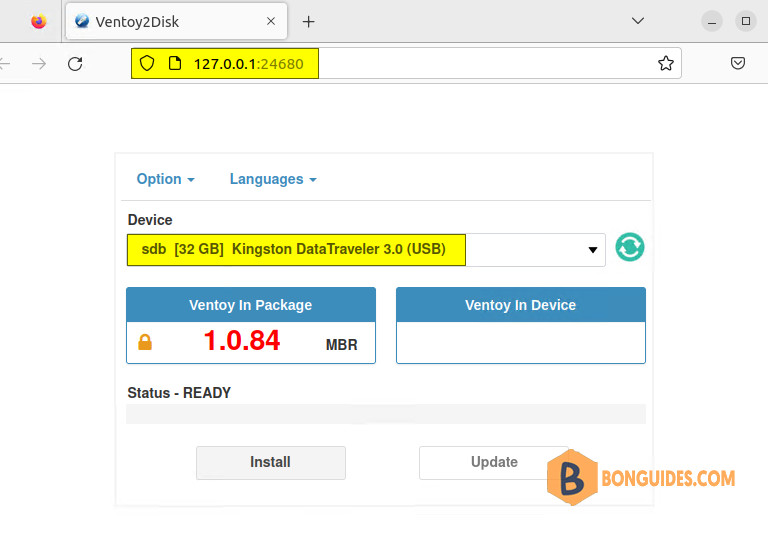
3. Nows day, almost computers are support UEFI boot mode. So, you need change the Partition Style from the Option menu. Considering you are going for a UEFI installation, it will be wise use GPT for partitioning style.
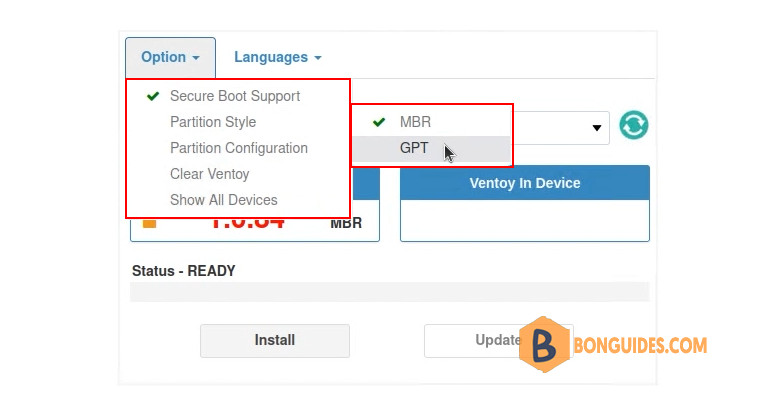
4. Once the things are set, hit the button. It will show you a couple of obligatory warnings. Confirm your action by clicking on twice. The USB pen drive will be formatted. Wait for at least a minute after the operation has been completed.
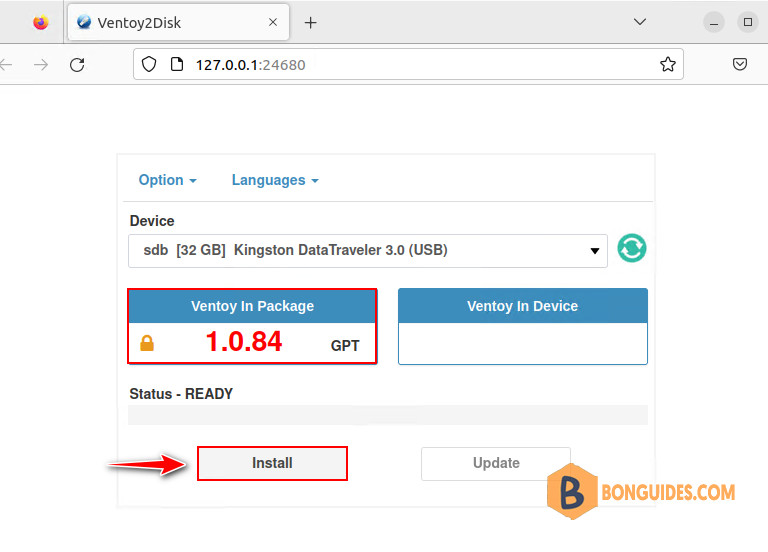
5. If the installation completes successfully, you should see a success message.
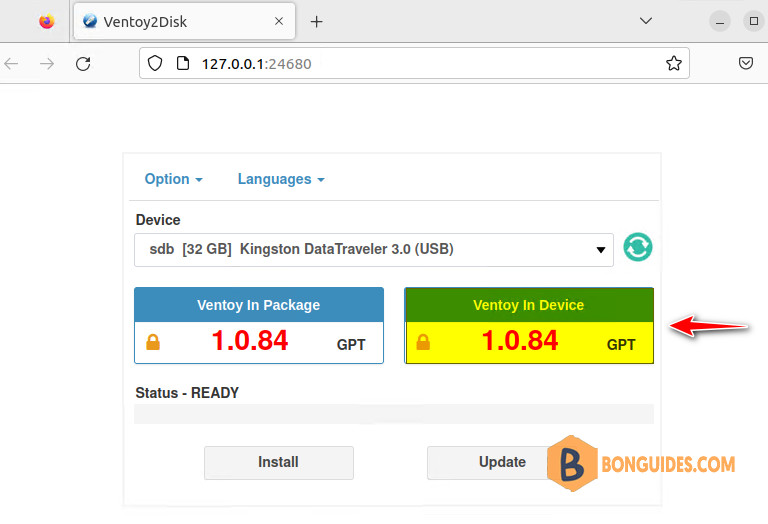
When you hit the install button, it creates two partitions on the USB disk.
- VTOYEFI: A small partition for the UEFI files for booting.
- Ventoy: A big and empty partition in ExFAT format where you’ll copy the ISO image into it.

6. Now, copy the ISO image of the Windows 10/11 into the bigger ExFAT partition on the USB disk.

Note
Note: Once the copying finishes, DO NOT RUSH to plug out the USB just yet. Click on the unmount option from the file manager. Chances are that some files are still being written and it may show an error message.

Wait for a few more minutes and you should see a message that it is safe to remove the disk. Now you can unplug it and use it on whichever system you want.

Using the bootable Windows 10/11 disk
1. You are almost there. Insert your bootable Windows USB key you created in the previous section. Start the computer and at boot time, press F2 or F10 or F12 repeatedly to go to the boot settings. In here, select to boot from your USB.
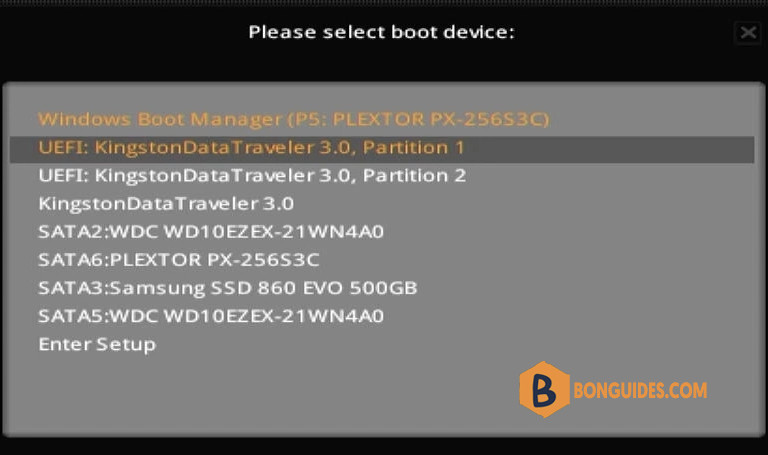
2. It takes a couple of minutes to start the Windows disk. You should see a screen like this, and it will give you the option to install Windows.

3. Select the option Boot in normal mode.
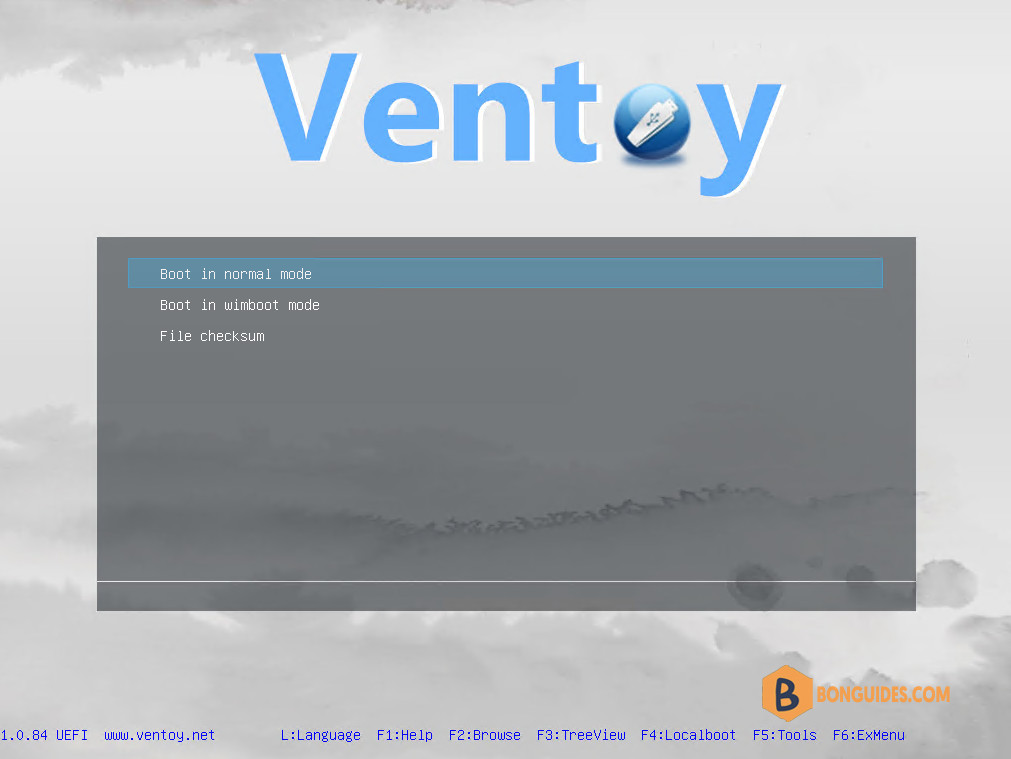
4. You’ll see that Windows 10/11 is being booted and it gives you the option to install or repair your system. You know what to do now from here.


That’s it! You can now simply use your USB pen drive to boot to Windows 10/11. You can even copy other images of operating systems to your Ventoy USB pen drive to create a personal library of operating systems.
Additionally, if you just want to create the Windows bootable USB disk only once. You can close the Terminal window then delete Ventoy from your system.
Не могу сделать загруз. флеху вин 10 на минте, при загрузке комп не видет
(использовал etcher и usb image writer)
-
Вопрос задан
-
3851 просмотр
Есть такая программа — unetbootin, она существует как для Linux, так и для Windows. Подсовываете ей дистрибутивный ISO-файл с Виндой, она раскрывает его на указанную вами флэшку, и дело сделано. Причём не требуется никаких взмахов бубном.
Пригласить эксперта
Попробуй winusb
sudo add-apt-repository ppa:nilarimogard/webupd8
sudo apt-get update
sudo apt-get install winusb
Форматируем нашу флеху в файловой системе ntfs.sudo mkfs.ntfs /dev/sdX
Запускаем прожигsudo winusb --install win10_x64.iso /dev/sdX
1) WinUSB — ищите в репозитории
2) Из ЛОР-а:
- форматнуть в ntfs
- поставить флаг boot
- ms-sys -7 /dev/sdX
- примонтировать исо и флешку
- просто скопировать файлы
WinUSB уже не разрабатывается, в качестве замены стоит использовать WoeUSB.
Первым делом стоит отформатировать флешку в NTFS, сделать это можно с помощью GParted. Далее устанавливаем WoeUSB, инструкцию по установке для вашего дистрибутива можете найти здесь. У программы есть простенький графический интерфейс, так что проблем возникнуть не должно
Есть еще вариант — mkusb-plug, она работает с ISO-файлами Windows 7–11, ну или winusb с офф сайта.
-
Показать ещё
Загружается…
Минуточку внимания
Learn how to create a bootable Windows USB on Ubuntu or Linux Mint using a free application called ‘WoeUSB’ — all detailed in this guide.
I don’t use Windows as my main OS but I do, from time-to-time, need to test something in it for this blog (like WSL). When I need to create a bootable Windows 10 USB I want to do it from my main OS —and that is Ubuntu.
There are a number of ways to write Windows to a USB on Linux distributions like Ubuntu but I’ve lost so many hours making a Windows USB in Ubuntu that fail to boot.
So the method I cover in this guide is the one I use as it’s not only an easy way to create a bootable Windows USB but also created one you can boot and install from!
Let’s get into the details.
WoeUSB is the app to use to make a bootable Windows 10 (or Windows 11) USB stick on Ubuntu.

Related Story
Installing Ubuntu in Windows 11 (WSL) is Now MUCH Easier
WoeUSB is free, open-source software that is available as both a graphical (GUI) tool and as a command-line (CLI) client you can run from any terminal emulator.
In this tutorial I use the WoeUSB GUI app.
You can use WoeUSB to make a bootable USB installer for various Windows releases, including Windows 7, Window 8.1, Windows 10, and the latest Windows 11 release.
All languages and all variants of Windows, including Pro, Home, N, 32-bit, and more, are supported. The tool works with both ‘legacy’ and ‘UEFI’ boot-modes.
Advanced installations will require you to dive into the WoeUSB CLI. This provides access to an array of flags, arguments, and options that enable you to create custom install images.
For most of us, the regular desktop WoeUSB app is fine.
To create a bootable Windows 10 USB on Ubuntu you need:
- WoeUSB installed
- Windows ISO file
- USB flash drive
- 4 GB minimum for Windows 10
- 8 GB minimum Windows 11
You can download Windows disc images from the Microsoft website. If you don’t already have one you should go there and get one.
You will need a valid Windows license to activate and use Windows fully. However, you don’t need a license to create a Windows USB installer, download an image file, or install the OS.
1. Install WoeUSB on Ubuntu

First the drawback: WoeUSB is no longer actively maintained.
However, the open-source community has stepped in to fork the app and continue development.
Better yet, we can add a personal package archive (PPA) to install WoebUSB on Ubuntu 20.04, 22.04, or 24.04 LTS (and those versions only, or Linux distributions based on them such as Linux Mint 21.x and 22.x series).
Run the following command in a Terminal to add the WoeUSB PPA to your system’s list of software sources:
sudo add-apt-repository ppa:tomtomtom/woeusb
Next, run this command to refresh the list of packages your system can see and install WoeUSB:
sudo apt update && sudo apt install woeusb-frontend-wxgtk
Let everything download, unpack, and compete before continuing.
2. Run WoeUSB

Now that you have installed WoeUSB in Ubuntu, open it from your desktop’s applications menu/grid (in Ubuntu with GNOME Shell press the Super key and type ‘WoeUSB’ to find it faster).
When the app opens first select your Windows ISO image using the file picker button in the ‘Sources’ section. Second, choose NTFS in the file system format section if you’re writing Windows 10 or 11 to a USB drive (for earlier Windows versions you can use FAT).
Finally, in the “Target device” section select on the USB drive you want to write the ISO to.
Don’t see your USB device listed in the ‘Target device’ section? Make sure it’s plugged in correctly then click the ‘refresh’ button to update the list of attached devices.
3. Create Windows 10 Bootable USB

The final step is to click “Install” — BUT before you do double-check you selected the correct drive. The install process will wipe/erase the contents of the selected drive and you will lose any data stored on it.
Other than that, the tool will do the rest on its own, without needing your input. Don’t be impatient; let it do its thing. If your USB drive is old, connected to a USB 2.0 port, or has poor sustained read/write speeds the flashing process can take a while.
Once write is complete, a notification appears.
After you see this close WoeUSB, safely eject the USB (don’t yank it out), and plug it in to a laptop/PC, and boot from it to install your chosen version of Windows.
Let me know how you get on down in the comments!
This tutorial is going to show you an easy way to create a Windows 10 bootable USB on Linux. I use Ubuntu 20.04 as an example. The method applies to any Linux distribution. I use Windows to do online banking because my bank doesn’t support Linux and sometimes play games that can’t run on Linux.
What you need
- A computer running Linux
- A USB flash drive at least 8GB
- Windows 10 ISO
Download Windows 10 ISO
First, you should download Windows 10 ISO from Microsoft official download link. Note that you might not be able to download the ISO from this link on a Windows computer. This download link is visible to users on Linux computer. Once downloaded, follow the instructions below.
Note: It’s recommended to download the Windows 10 April 2018 update ISO, because the October Update ISO contains a file that is larger than 4GB, which can not be copied to a FAT32 partition.

Update: Microsoft doesn’t allow you to download the Windows 10 April 2018 Update ISO from their website anymore. You can download the ISO via this link: Win10 1803 English x64 ISO
Creating a Windows 10 Bootable USB for UEFI Firmware
This method works for UEFI firmware and is very simple. You create a GUID partition table on your USB stick, create a FAT32 file system on it, and then mount Windows 10 ISO image and copy those Windows 10 files to your USB stick and you are done. The following is a step-by-step guide.
First, install GParted partition editor on your Linux distribution. Ubuntu users run the following command.
sudo apt install gparted
Then insert your USB stick to your computer. Make sure you back up important files in your USB stick if there’s any. Next, launch Gparted. You will need to enter your password in order to use GParted.

Select your USB stick from the drop-down menu on the upper-right corner. My USB stick is /dev/sdb. Yours may be different.

If there’s a key icon after the partition name, that means the partition is mounted. Make sure all partitions on your USB stick are unmounted. To unmount a partition, simply right-click on it and select unmount.

Next, on the menu bar, select Device > Create partition table.

Choose GPT as the partition table type and click Apply.

Then right-click on the unallocated space and select New to create a new partition.

Change file system type from ext4 to fat32 and click Add.
Note: The install.wim file in Windows 10 October 2018 update ISO is 4.1G, so if you downloaded this ISO image, you need to change ext4 to ntfs. If you downloaded Windows 10 April 2018 Update ISO, which contains a 3.9G size install.wim file, you can change ext4 to fat32
Update: It is my observation that my NTFS formatted USB stick isn’t bootable on my old laptop, which was bought in 2012. However, it is bootable on my desktop computer, which was bought in 2017. It has a graphical UEFI firware (I can use my mouse to configure firmware settings).

Next, click the green check button on the toolbar to apply this operation. Once that’s done, close GParted (This is important), then find your Windows 10 ISO in file manager. Open it with disk image mounter.

Open the mounted file system. Select all files and folders and copy them to your USB stick.

Sometimes the file manager on Ubuntu hangs and it seems that the copy operation has stopped. Actually it’s working, just be patient. When you see a check mark, it means the copy operation has finished.

If your file manager doesn’t have the Disk image mounter in the context menu, then you can use the following commands to mount. The first command will create a mount point for Windows 10 ISO and the second command will mount Windows 10 ISO under that mount point.
sudo mkdir /mnt/windows10/
sudo mount -t auto -o loop /path/to/window-10-iso /mnt/windows10/
Now in your file manager, go to /mnt/windows10/ and copy all files and folders to your USB stick.
Once the file and folders are copied, your windows 10 bootable USB is created! You can shut down your computer, boot it from this USB stick and install Windows 10 in UEFI mode. Keep in mind that you may need to disable compatibility support module (CSM) in the firmware in order to boot in UEFI mode. You may also need to remove USB stick from your computer and insert it back in order for the firmware to detect the boot loader on your USB stick.
Boot Windows 10 ISO Installer without USB (BIOS & UEFI)
Ever wondered if you can boot Windows 10 ISO installer without a USB flash drive? Yes, you can do it with GRUB2, which is the standard boot loader on Linux.
GRUB2 can not boot Windows 10 ISO directly. You need to create a separate NTFS partition on your hard disk or SSD with a partition editor like GParted and extract the Windows 10 ISO to that partition. Download the Windows 10 ISO file. The latest Windows 10 ISO file is 5.8G. The new NTFS partition should be at least 7G and it should not be used to store any other files.

Then find your Windows 10 ISO in file manager. Open it with disk image mounter.

Open the mounted file system. Select all files and folders and copy them to the NTFS partition.

Sometimes the file manager on Ubuntu hangs and it seems that the copy operation has stopped. Actually, it’s working. Just be patient. When you see a checkmark, it means the copy operation has finished.

Next, open up a terminal window and edit the /etc/grub.d/40_custom file with a text editor such as Nano.
sudo nano /etc/grub.d/40_custom
In this file, we can add custom entries to the GRUB boot menu. In this case, we want to add an entry to boot the Windows 10 installer. If your computer still uses the traditional BIOS firmware, then add the following lines in this file.
menuentry "Windows-10-Installer.iso" {
set root=(hd0,6)
insmod part_msdos
insmod ntfs
insmod ntldr
#uncomment the following line if your computer has multiple hard drives.
#drivemap -s (hd0) ${root}
ntldr /bootmgr
}
My NTFS partition is the 6th partition on my first disk, so I use (hd0,6) as the root. You can run sudo parted -l command to check your NTFS partition number. If your computer has multiple hard drives, use the drivemap command to set the partition (hd0,6) as the first hard disk, so Windows will be able to boot.
If your computer uses UEFI firmware, then add the following text in this file.
menuentry "Windows-10-Installer.iso" {
set root=(hd0,6)
insmod part_gpt
insmod ntfs
insmod chain
chainloader /efi/boot/bootx64.efi
}

Save and close the file. (Press Ctrl+O, then press Enter to save a file in Nano text editor. Press Ctrl+X to exit.)
Then update GRUB boot menu.
sudo grub-mkconfig -o /boot/grub/grub.cfg
or
sudo grub2-mkconfig -o /boot/grub2/grub.cfg
Next, set GRUB to boot the Windows 10 installer for the next boot with the following command.
sudo grub-reboot Windows-10-Installer.iso
or
sudo grub2-reboot Windows-10-Installer.iso
Unplug all your external USB storage devices, then reboot your computer. GRUB will choose the Windows 10 installer.

GRUB2 can also boot Linux ISO files stored on the hard drive, so you don’t need to create Linux live USB.
- How to Boot ISO Files From GRUB2 Boot Loader
Creating a Windows 10 Bootable USB for Legacy BIOS Using WoeUSB
WoeUSB is a fork of WinUSB. Both of them are open-source software (licensed in GPL) for making Windows bootable USB sticks on Linux platform, but the latter hasn’t been updated since 2012. You may be wondering why it’s named WoeUSB. The author said it’s a GNU convention to abbreviate software that support Windows to “woe”.
To install WoeUSB on Ubuntu 14.04/16.04/17.04, you can use the following PPA. Simply open up a terminal window and run the following commands one by one. Other Linux distro users can compile this software by following the instructions on the Github project page.
sudo add-apt-repository ppa:nilarimogard/webupd8 sudo apt update sudo apt install woeusb
This PPA contains many other software. If you don’t need them, you can now remove this PPA from your system.
sudo add-apt-repository --remove ppa:nilarimogard/webupd8 sudo apt update
You can launch WoeUSB from Unity Dash or your application menu.

You can also start it from command line with:
woeusbgui
It’s very easy to use the WoeUSB GUI. Select Windows ISO image and your target USB device. Make sure your data on the USB device is backed up before hitting the Install button.

Then wait for the installation to complete.

Once done, you can use the bootable USB to install Windows 10 on your computer.
How to Use WoeUSB From the Command Line
First, find the device name of your USB stick using the following command.
lsblk

Mine is /dev/sdb. Make sure your USB is unmounted with the following command. Replace /dev/sdb1 with your own partition name.
sudo umount /dev/sdb1
Then create a bootable Windows 10 USB like below. Red texts shoudl be adapted to your own ISO file name and USB device name. The -v (--verbose) option will give more detailed output.
sudo woeusb -v --device windows-10.iso /dev/sdb
In my test, the Windows 10 USB created with WoeUSB can boot in both legacy and UEFI mode on my old computer. On my new computer, it can boot in legacy mode but failed in UEFI mode. I don’t know the exact reason, but it’s probably because of bug in this software.
That’s it! I hope this tutorial helped you create windows 10 bootable USB on Ubuntu or any Linux distribution. As always, if you found this post useful, then subscribe to our free newsletter to get new tutorials.
Rate this tutorial
[Total: 116 Average: 4.3]


